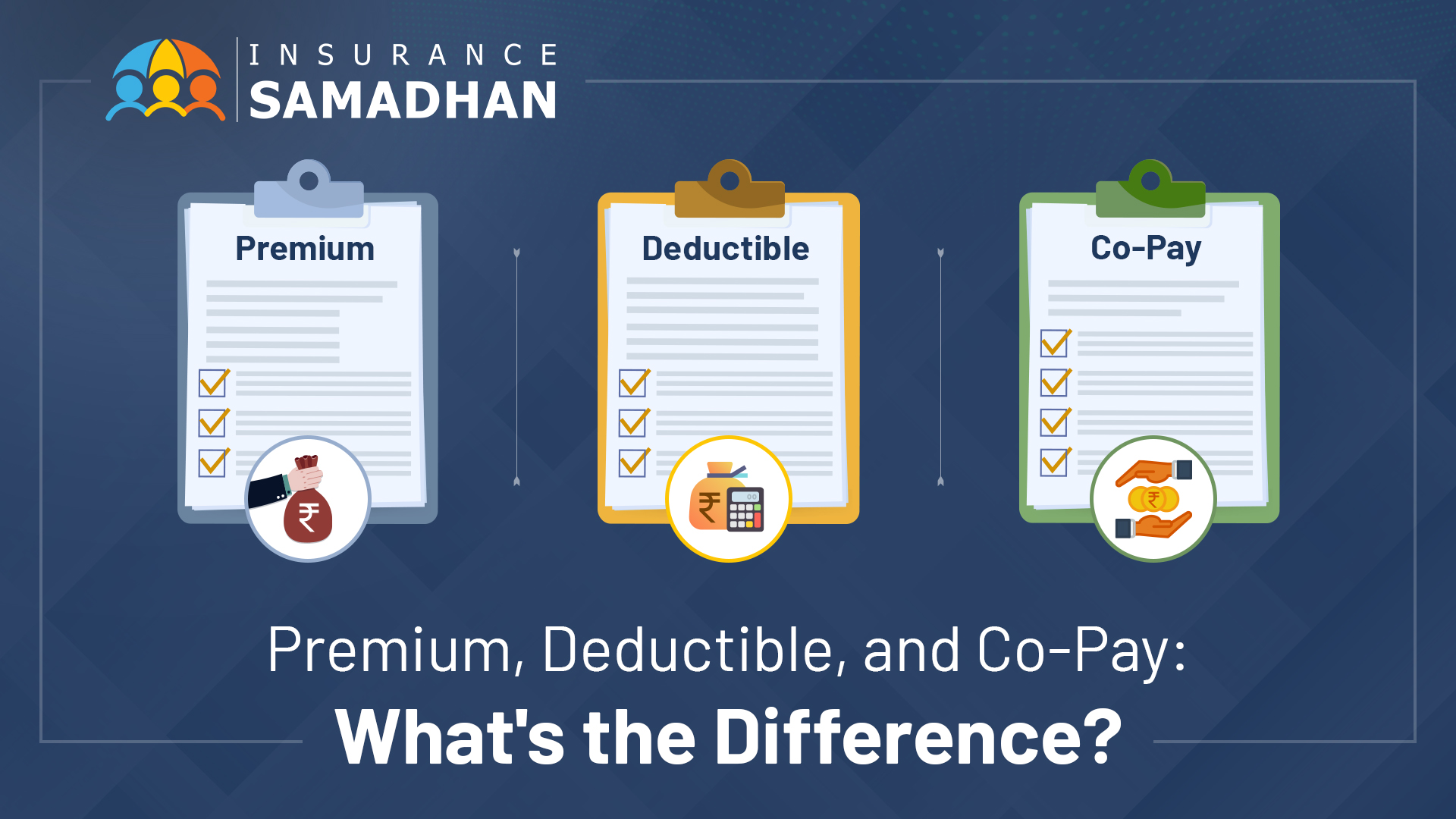Introduction
When you’re shopping for insurance, you’ll encounter terms like premium, deductible, and co-pay that can quickly make your head spin. If you’ve ever found yourself nodding along while an agent explains these concepts but secretly wondering what they actually mean then you’re not alone. At Insurance Samadhan, we are committed to educating people about insurance so you never have to sign on the dotted line without fully understanding the crucial terms.

The Three Cost Components of Your Insurance
Think of insurance as a financial arrangement with three main cost components that work together:
1. Premium: What You Pay to Have Insurance
Your premium is simply the amount you pay to the insurance company to keep your policy active. Think of it as your “membership fee” to the insurance club. Here’s what you need to know about premiums:
a) It’s typically paid monthly, quarterly, half-yearly, or annually
b) If you don’t pay your premium on time, your coverage may lapse
c) Premiums are determined based on your risk profile (age, health, driving record, etc.)
d) Lower premiums generally mean higher deductibles or co-pays (we’ll explain why shortly)
2. Deductible: What You Pay Before Insurance Kicks In
Your deductible is the amount you need to pay out of your own pocket before your insurance company starts covering costs. It’s like a threshold you must cross before unlocking your insurance claim benefits. For example:
a) If your health insurance has a ₹50,000 deductible and your hospital bill is ₹2 lakhs, you’ll pay the first ₹50,000, and your insurer covers the remaining ₹1.5 lakhs
b) Deductibles usually reset annually
c) Some policies have separate deductibles for different types of services
3. Co-Pay: What You Share With Your Insurer
A co-pay (or co-payment) is your share of the cost that you pay each time you use a service, even after meeting your deductible. It’s typically expressed as a percentage or a fixed amount. For example:
a) A 20% co-pay on a ₹10,000 doctor visit means you pay ₹2,000 and your insurer pays ₹8,000
b) Co-pays apply to each service or insurance claim you make
c) Unlike deductibles, co-pays usually don’t count toward your annual out-of-pocket maximum
How These Three Elements Work Together: Real-Life Scenarios
To help you understand how these three elements interact, let’s walk through some practical examples we’ve seen at Insurance Samadhan:
Scenario 1: Health Insurance
Imagine you have a health insurance policy with:
a) Annual premium: ₹15,000
b) Annual deductible: ₹25,000
c) Co-pay: 20% after deductible
If you’re hospitalised with a bill of ₹3 lakhs, here’s how it breaks down:
a) You’ve already paid your annual premium of ₹15,000 to have coverage
b) You pay the first ₹25,000 as your deductible
c) Of the remaining ₹2,75,000, you pay 20% as co-pay (₹55,000)
d) Your insurance covers the rest: ₹2,20,000
Your total out-of-pocket cost: ₹25,000 (deductible) + ₹55,000 (co-pay) = ₹80,000 (plus your premium)
Scenario 2: Motor Insurance
For a comprehensive car insurance policy with:
a) Annual premium: ₹8,000
b) Deductible: ₹2,000 per claim
c) No co-pay
If you have an accident with repairs costing ₹50,000:
a) You’ve already paid your annual premium of ₹8,000
b) You pay the ₹2,000 deductible
c) Your insurance covers the remaining ₹48,000
Your total out-of-pocket cost: ₹2,000 (plus your premium)
Making Smart Choices: How to Balance These Costs
At Insurance Samadhan, we suggest you find the right balance between these three elements based on your unique situations. Here’s our advice:
When to Choose Higher Premiums:
1. You have chronic health conditions and frequently need medical care
2. You live in an area with high accident rates or theft (for motor insurance)
3. You can’t afford to pay a large lump sum if something happens
4. You prefer predictable monthly costs over unpredictable expenses
When to Choose Higher Deductibles:
1. You have substantial emergency savings
2. You rarely need to make claims
3. You’re in good health or a safe driver
4. You want to lower your monthly costs
When to Accept Higher Co-Pays:
1. You don’t mind sharing costs if major expenses arise
2. You typically only need routine, lower-cost services
3. You want to reduce your premium without a very high deductible
4. You’ve calculated your worst-case scenario and can handle it
Common Misconceptions
In our daily work at Insurance Samadhan, we encounter these frequent misunderstandings:
Misconception 1: “The Premium is the Only Cost to Consider”
Many people focus solely on the premium and ignore deductibles and co-pays. This is like comparing two phones based only on their price tags, without considering their features or quality.
Misconception 2: “Lower Premium Always Means Better Value”
A lower premium usually means higher out-of-pocket costs when you actually need to use your insurance. We always ask our clients: “Can you afford the deductible if something happens tomorrow?”
Misconception 3: “No Deductible Plans are Always Better”
Zero-deductible plans typically come with much higher premiums. For someone who rarely makes insurance claims, this could mean paying thousands extra for coverage they don’t utilise.
Misconception 4: “Co-Pay is Just Another Word for Deductible”
We often meet clients who confuse these terms. Remember: your deductible is what you pay before insurance starts paying; your co-pay is what you continue to share after insurance starts paying.
Take Control of Your Insurance Costs
Understanding the relationship between premiums, deductibles, and co-pays empowers you to make informed insurance decisions. Don’t let confusing terms lead you into policies that don’t serve your needs.
Remember, the cheapest policy isn’t always the most economical in the long run, and the most expensive policy isn’t necessarily the best. The right choice depends on your personal circumstances, risk tolerance, and financial situation
Click here to register your complaint with Insurance Samadhan
Visit our website: insurancesamadhan.com
Mail us at corporate@insurancesamadhan.com